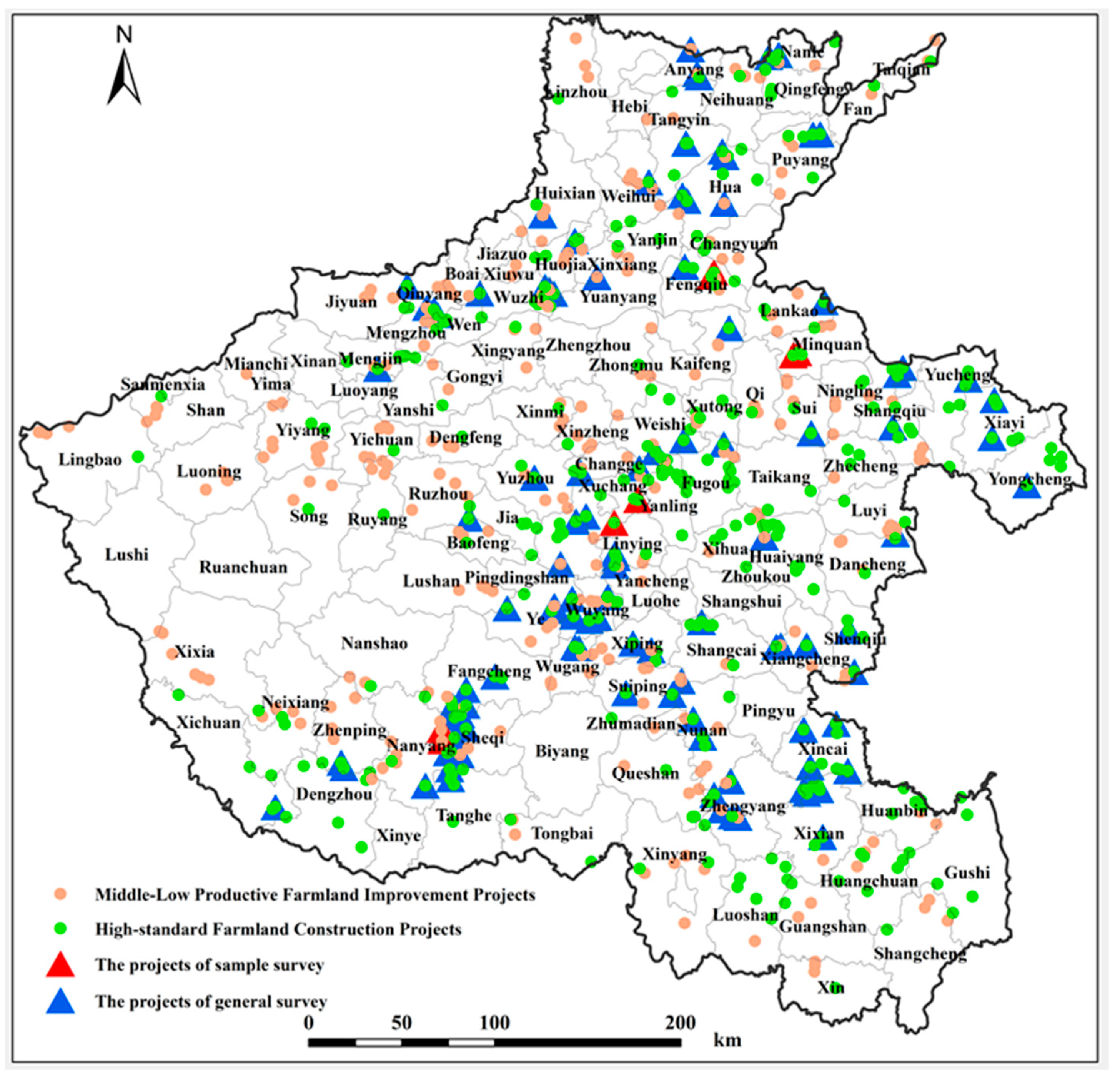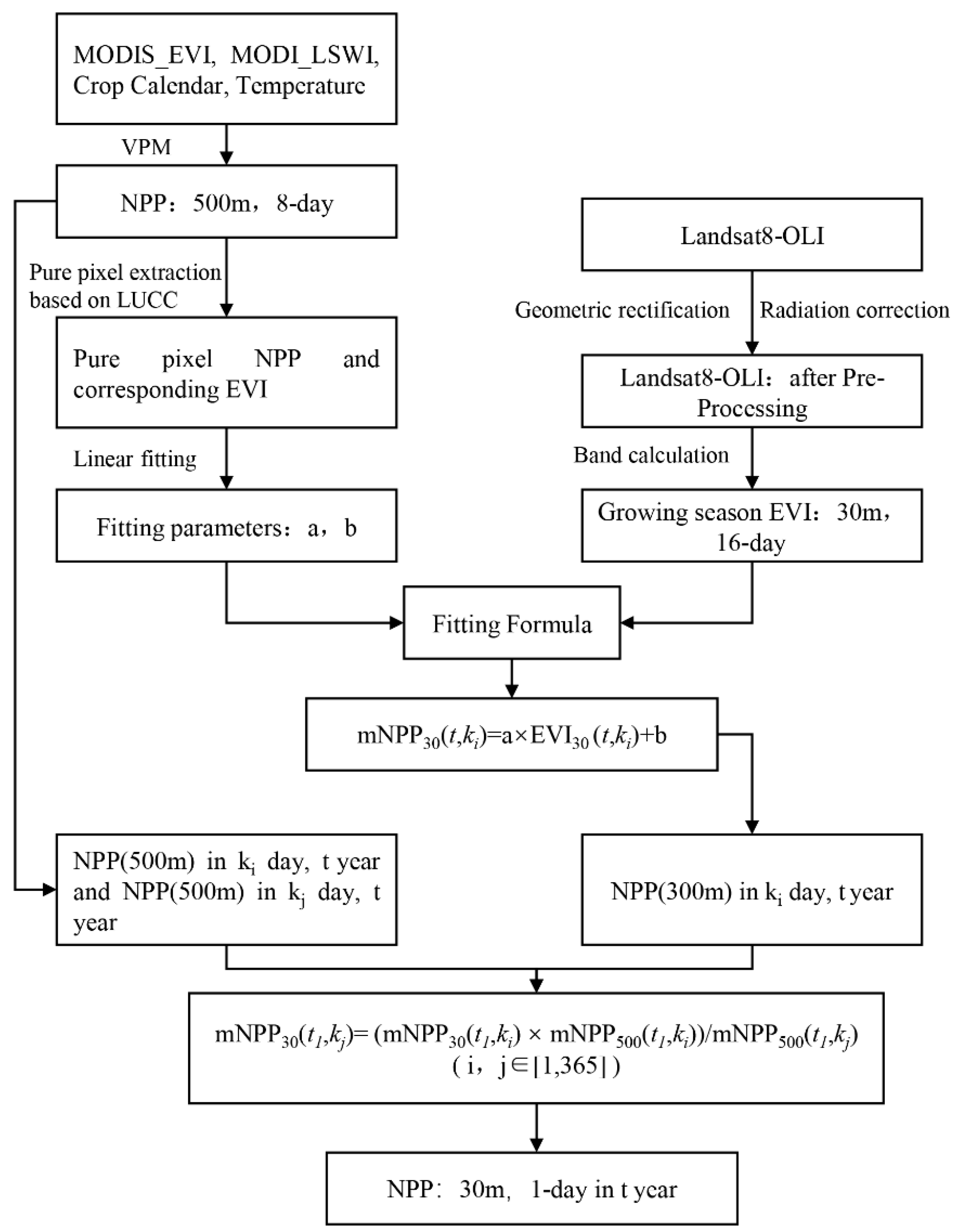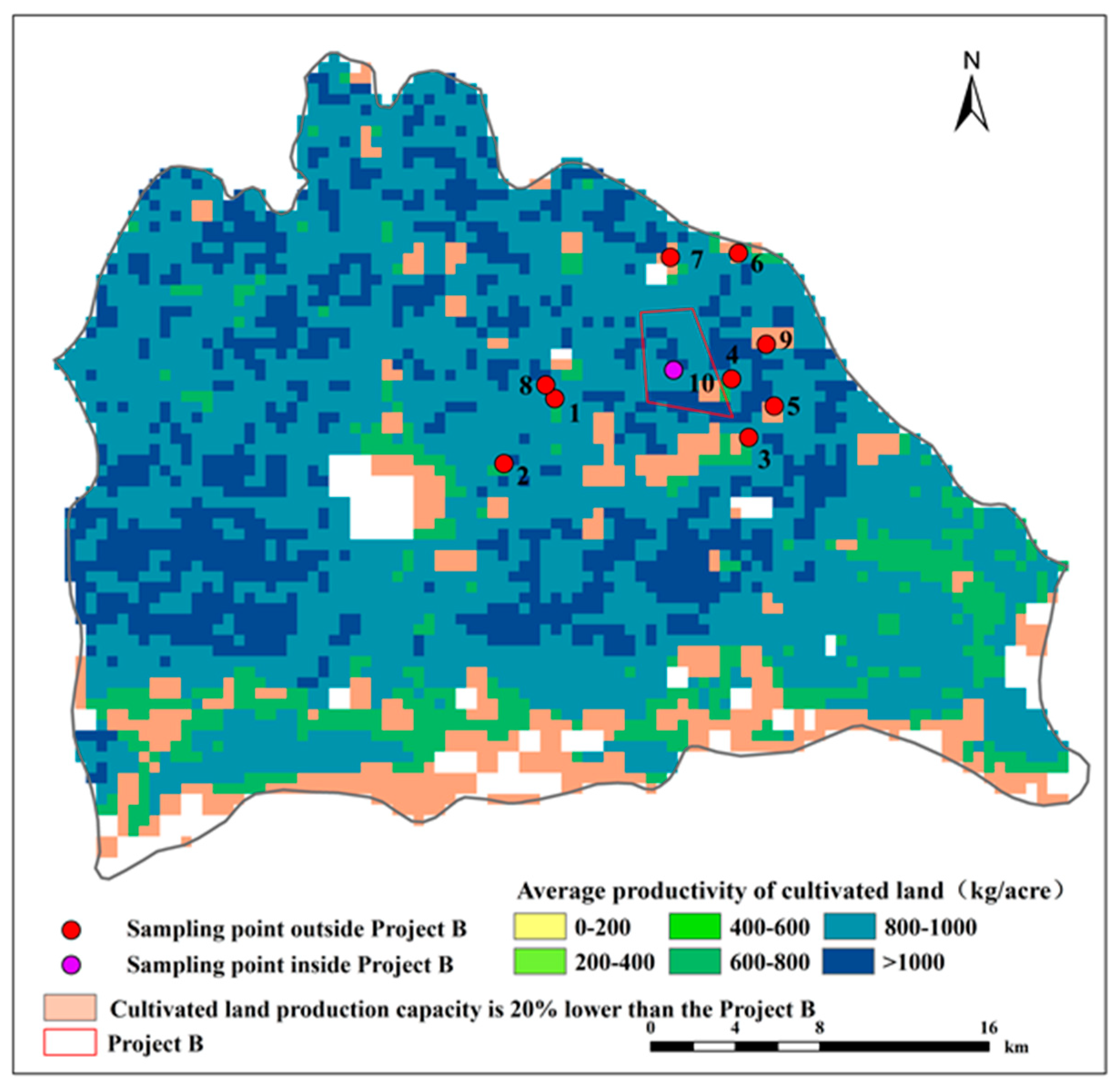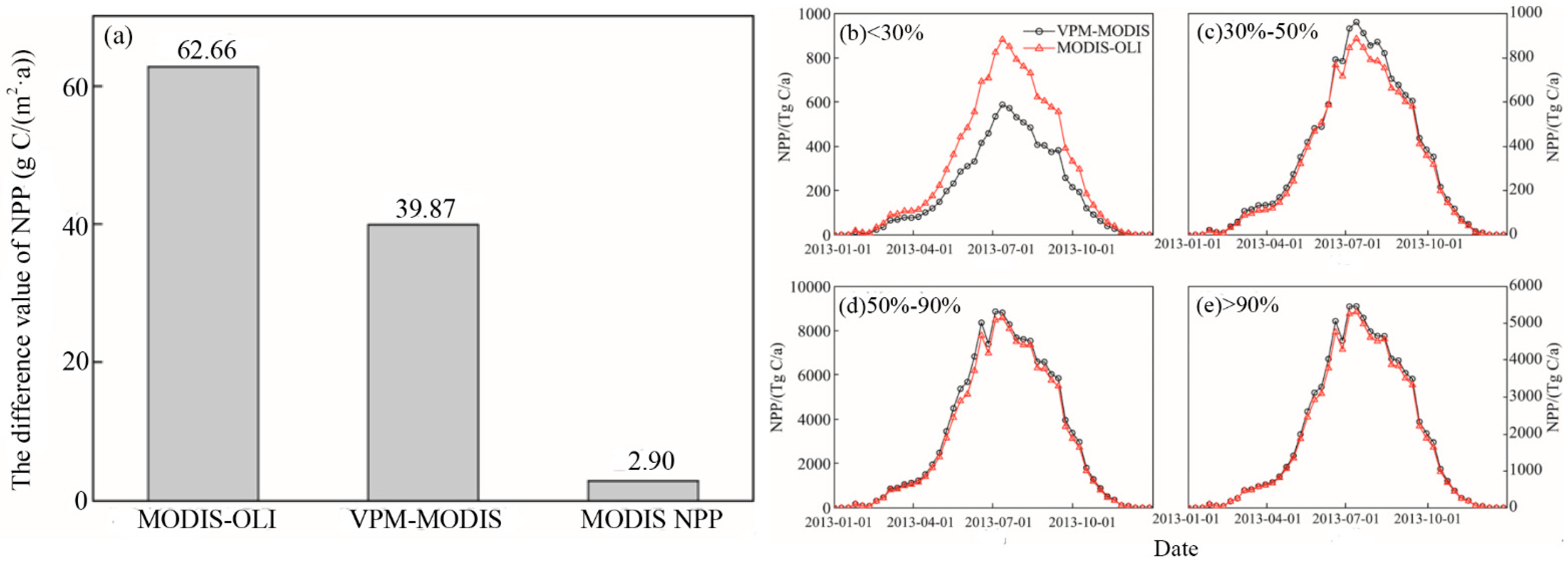Satellite-Based Evidences to Improve Cropland Productivity on the High-Standard Farmland Project Regions in Henan Province, China
Abstract
:1. Introduction
2. Materials and Methods
2.1. Study Area
2.2. Data
2.3. Methodology
2.3.1. Satellite Monitoring Method of General Survey and Sampling Survey to Evaluate the Effectiveness of HSF Construction
- (1)
- General survey
- (2)
- Sampling survey
- (1)
- Taking into account different agri-ecological conditions;
- (2)
- Belonging to the general sample project region;
- (3)
- Taking into account HSF construction projects and MLPF transformation projects;
- (4)
- Taking into account the availability of remote sensing images;
- (5)
- Taking into account the balanced distribution of sampling project regions, with the number of sampling project regions in each county not exceeding two.
2.3.2. Remote Sensing Monitoring and Detection of Cropland Productivity
- (1)
- Remote sensing estimation of cropland productivity based on VPM
- (2)
- Time series linear fitting model
2.3.3. Indicators and Algorithms for Remote Sensing and Evaluation of HSF Construction Effectiveness
- (1)
- Improvement of cropland productivity level (CPL)
- (2)
- Improvement of disaster resistance ability (DRA)
- (3)
- Improvement of homogenous yield degree (HYD)
3. Results
3.1. Improvement of Cropland Productivity Level after HSF Construction
3.2. The Improvement of Disaster Resistance Ability of Cropland after HSF Construction
3.3. The Improvement of Homogenous Yield Degree of Cropland after HSF Construction
4. Discussion
5. Conclusions
Author Contributions
Funding
Data Availability Statement
Acknowledgments
Conflicts of Interest
References
- Godfray, H.C.J.; Beddington, J.R.; Crute, I.R.; Haddad, L.; Lawrence, D.; Muir, J.F.; Pretty, J.; Robinson, S.; Thomas, S.M.; Toulmin, C. Food security: The challenge of feeding 9 billion people. Science 2010, 327, 812–818. [Google Scholar] [CrossRef] [Green Version]
- Pradhan, P.; Fischer, G.; van Velthuizen, H.; Reusser, D.E.; Kropp, J.P. Closing yield gaps: How sustainable can we be? PLoS ONE 2015, 10, e0129487. [Google Scholar] [CrossRef] [PubMed] [Green Version]
- Campbell, B.M.; Beare, D.J.; Bennett, E.M.; Hall-Spencer, J.M.; Ingram, J.S.; Jaramillo, F.; Ortiz, R.; Ramankutty, N.; Sayer, J.A.; Shindell, D. Agriculture production as a major driver of the Earth system exceeding planetary boundaries. Ecol. Soc. 2017, 22, 8. [Google Scholar] [CrossRef]
- Gerten, D.; Heck, V.; Jägermeyr, J.; Bodirsky, B.L.; Fetzer, I.; Jalava, M.; Kummu, M.; Lucht, W.; Rockstrom, J.; Schaphoff, S.; et al. Feeding ten billion people is possible within four terrestrial planetary boundaries. Nat. Sustain. 2020, 3, 200–208. [Google Scholar] [CrossRef]
- Neumann, K.; Verburg, P.H.; Stehfest, E.; Müller, C. The yield gap of global grain production: A spatial analysis. Agric. Syst. 2010, 103, 316–326. [Google Scholar] [CrossRef]
- Ray, D.K.; Mueller, N.D.; West, P.C.; Foley, J.A. Yield trends are insufficient to double global crop production by 2050. PLoS ONE 2013, 8, e66428. [Google Scholar]
- Ray, D.K.; Foley, J.A. Increasing global crop harvest frequency: Recent trends and future directions. Environ. Res. Lett. 2013, 8, 044041. [Google Scholar] [CrossRef]
- Tilman, D.; Balzer, C.; Hill, J.; Befort, B.L. Global food demand and the sustainable intensification of agriculture. Proc. Natl. Acad. Sci. USA 2011, 108, 20260–20264. [Google Scholar] [CrossRef] [Green Version]
- Wu, W.; Yu, Q.; You, L.; Chen, K.; Tang, H.; Liu, J. Global cropping intensity gaps: Increasing food production without cropland expansion. Land Use Pol. 2018, 76, 515–525. [Google Scholar] [CrossRef]
- Chen, W.; Ye, X.; Li, J.; Fan, X.; Liu, Q.; Dong, W. Analyzing requisition–compensation balance of farmland policy in China through telecoupling: A case study in the middle reaches of Yangtze River Urban Agglomerations. Land Use Pol. 2019, 83, 134–146. [Google Scholar] [CrossRef]
- Song, W.; Pijanowski, B.C. The effects of China’s cultivated land balance program on potential land productivity at a national scale. Appl. Geogr. 2014, 46, 158–170. [Google Scholar] [CrossRef]
- Yan, H.; Liu, J.; Huang, H.Q.; Tao, B.; Cao, M. Assessing the consequence of land use change on agricultural productivity in China. Glob. Planet. Chang. 2009, 67, 13–19. [Google Scholar] [CrossRef]
- Kuang, W.; Liu, J.; Tian, H.; Shi, H.; Dong, J.; Song, C.; Li, X.; Du, G.; Hou, Y.; Lu, D.; et al. Cropland redistribution to marginal lands undermines environmental sustainability. Natl. Sci. Rev. 2022, 9, nwab091. [Google Scholar] [CrossRef] [PubMed]
- Yan, H.; Ji, Y.; Liu, J.; Liu, F.; Hu, Y.; Kuang, W. Potential promoted productivity and spatial patterns of medium-and low-yield cropland land in China. J. Geogr. Sci. 2016, 26, 259–271. [Google Scholar] [CrossRef] [Green Version]
- Ministry of Agriculture and Rural Affairs of the People’s Republic of China. Notice of the General Office of the Ministry of Agriculture and Rural Affairs on Accelerating the Construction of a High-Standard Farmland Construction Planning System; Gazette of the Ministry of Agriculture and Affairs of the People’s Republic of China: Beijing, China, 2021; Volume 11, pp. 92–93.
- Maselli, F.; Moriondo, M.; Angeli, L.; Fibbi, L.; Bindi, M. Estimation of wheat production by the integration of MODIS and ground data. Int. J. Remote Sens. 2011, 32, 1105–1123. [Google Scholar] [CrossRef]
- Becker-Reshef, I.; Vermote, E.; Lindeman, M.; Justice, C. A generalized regression-based model for forecasting winter wheat yields in Kansas and Ukraine using MODIS data. Remote Sens. Environ. 2010, 114, 1312–1323. [Google Scholar] [CrossRef]
- Johnson, D.M. An assessment of pre-and within-season remotely sensed variables for forecasting corn and soybean yields in the United States. Remote Sens. Environ. 2014, 141, 116–128. [Google Scholar] [CrossRef]
- Azzari, G.; Lobell, D.B. Landsat-based classification in the cloud: An opportunity for a paradigm shift in land cover monitoring. Remote Sens. Environ. 2017, 202, 64–74. [Google Scholar] [CrossRef]
- Jin, Z.; Azzari, G.; You, C.; Di Tommaso, S.; Aston, S.; Burke, M.; Lobell, D.B. Smallholder maize area and yield mapping at national scales with Google Earth Engine. Remote Sens. Environ. 2019, 228, 115–128. [Google Scholar] [CrossRef]
- Xiong, J.; Thenkabail, P.S.; Tilton, J.C.; Gumma, M.K.; Teluguntla, P.; Oliphant, A.; Congalton, R.G.; Yadav, K.; Gorelick, N. Nominal 30-m cropland extent map of continental Africa by integrating pixel-based and object-based algorithms using Sentinel-2 and Landsat-8 data on Google Earth Engine. Remote Sens. 2017, 9, 1065. [Google Scholar] [CrossRef] [Green Version]
- Qader, S.H.; Dash, J.; Alegana, V.A.; Khwarahm, N.R.; Tatem, A.J.; Atkinson, P.M. The role of earth observation in achieving sustainable agricultural production in arid and semi-arid regions of the world. Remote Sens. 2021, 13, 3382. [Google Scholar] [CrossRef]
- Ghazaryan, G.; König, S.; Rezaei, E.E.; Siebert, S.; Dubovyk, O. Analysis of drought impact on croplands from global to regional scale: A remote sensing approach. Remote Sens. 2020, 12, 4030. [Google Scholar] [CrossRef]
- Peng, Y.; Gitelson, A.A.; Keydan, G.; Rundquist, D.C.; Moses, W. Remote estimation of gross primary production in maize and support for a new paradigm based on total crop chlorophyll content. Remote Sens. Environ. 2011, 115, 978–989. [Google Scholar] [CrossRef]
- Peng, Y.; Gitelson, A.A. Remote estimation of gross primary productivity in soybean and maize based on total crop chlorophyll content. Remote Sens. Environ. 2012, 117, 440–448. [Google Scholar] [CrossRef]
- Wu, C.; Niu, Z.; Gao, S. Gross primary production estimation from MODIS data with vegetation index and photosynthetically active radiation in maize. J. Geophys. Res.-Atmos. 2010, 115, D12. [Google Scholar] [CrossRef] [Green Version]
- Chen, J.; Yan, H.; Wang, S.; Gao, Y.; Huang, M.; Wang, J.; Xiao, X. Estimation of Gross Primary Productivity in Chinese Terrestrial Ecosystems by Using VPM Model. Quat. Sci. 2014, 34, 732–742. (In Chinese) [Google Scholar]
- Yan, H.; Xiao, X.; Huang, H. Satellite observed crop calendar and its spatio-temporal characteristics in multiple cropping area of Huang-Huai-Hai Plain. Acta Ecol. Sin. 2010, 30, 2416–2423. (In Chinese) [Google Scholar]
- Zhang, Y.; Yu, Q.; Jiang, J.I.E.; Tang, Y. Calibration of Terra/MODIS gross primary production over an irrigated cropland on the North China Plain and an alpine meadow on the Tibetan Plateau. Glob. Chang. Biol. 2008, 14, 757–767. [Google Scholar] [CrossRef]
- Niu, Z.; Yan, H.; Huang, M.; Hu, Y.; Chen, J. Agricultural Productivity Estimation with MODIS-OLI Fusion Data. Nat. Resour. 2016, 31, 875–885. (In Chinese) [Google Scholar]
- Luo, L.; Yan, H.; Niu, Z. Comparative Analysis on Three Multi-Source Remote Sensing Data Fusion Models in Monitoring Farmland Productivity. ISPRS Int. J. Geoinf. 2018, 20, 268–279. (In Chinese) [Google Scholar]
- Wang, J.; Wang, J.; Ye, H.; Liu, Y.; He, H. An interpolated temperature and precipitation dataset at 1-km grid resolution in China (2000–2012). China Sci. Data 2017, 2, 88–95. [Google Scholar]
- Ren, X.; He, H.; Zhang, L.; Yu, G. Global radiation, photosynthetically active radiation, and the diffuse component dataset of China, 1981–2010. Earth Syst. Sci. Data Discuss. 2018, 10, 1217–1226. [Google Scholar] [CrossRef] [Green Version]
- Xiao, X.; Hollinger, D.; Aber, J.; Goltz, M.; Davidson, E.A.; Zhang, Q.; Moore III, B. Satellite-based modeling of gross primary production in an evergreen needleleaf forest. Remote Sens. Environ. 2004, 89, 519–534. [Google Scholar] [CrossRef]
- Xiao, X.; Zhang, Q.; Braswell, B.; Urbanski, S.; Boles, S.; Wofsy, S.; Berrien, M.; Ojima, D. Modeling gross primary production of temperate deciduous broadleaf forest using satellite images and climate data. Remote Sens. Environ. 2004, 91, 256–270. [Google Scholar] [CrossRef]
- Albrizio, R.; Steduto, P. Photosynthesis, respiration and conservative carbon use efficiency of four field grown crops. Agric. For. Meteorol. 2003, 116, 19–36. [Google Scholar] [CrossRef]
- Yan, H.; Fu, Y.; Xiao, X.; Huang, H.Q.; He, H.; Ediger, L. Modeling gross primary productivity for winter wheat–maize double cropping system using MODIS time series and CO2 eddy flux tower data. Agric. Ecosyst. Environ. 2009, 129, 391–400. [Google Scholar] [CrossRef]
- Zhu, X.; Chen, J.; Gao, F.; Chen, X.; Masek, J.G. An enhanced spatial and temporal adaptive reflectance fusion model for complex heterogeneous regions. Remote Sens. Environ. 2010, 114, 2610–2623. [Google Scholar] [CrossRef]
- Zhang, Y.; Xiao, X.; Wu, X.; Zhou, S.; Zhang, G.; Qin, Y.; Dong, J. A global moderate resolution dataset of gross primary production of vegetation for 2000–2016. Sci. Data 2017, 4, 170165. [Google Scholar] [CrossRef] [Green Version]
- Wang, Z.; Xiao, X.; Yan, X. Modeling gross primary production of maize cropland and degraded grassland in northeastern China. Agric. For. Meteorol. 2010, 150, 1160–1167. [Google Scholar] [CrossRef]
- Niu, Z.; Yan, H.; Chen, J.; Huang, M.; Hu, Y.; Wang, S. Comparison of crop gross primary productivity estimated with VPM model and MOD17 product in field ecosystem of China. Trans. Chin. Soc. Agric. Eng. 2016, 32, 191–198. (In Chinese) [Google Scholar]
- Running, S.W.; Zhao, M. Daily GPP and Annual NPP (MOD17A2/A3) Products NASA Earth Observing System MODIS Land Algorithm; MOD17 User’s Guide; LP DAAC: Sioux Falls, SD, USA, 2015; Volume 2015, pp. 1–28. [Google Scholar]
- Wang, H.; Jia, G.; Fu, C.; Feng, J.; Zhao, T.; Ma, Z. Deriving maximal light use efficiency from coordinated flux measurements and satellite data for regional gross primary production modeling. Remote Sens. Environ. 2010, 114, 2248–2258. [Google Scholar] [CrossRef]
- Wellington, M.J.; Kuhnert, P.; Renzullo, L.J.; Lawes, R. Modelling Within-Season Variation in Light Use Efficiency Enhances Productivity Estimates for Cropland. Remote Sens. 2022, 14, 1495. [Google Scholar] [CrossRef]
- Liu, H.; Yang, P.; Wu, W.; Li, G.; You, L. Spatio-temporal changes in Chinese crop patterns over the past three decades. J. Geogr. Sci. 2016, 71, 840–851. (In Chinese) [Google Scholar]
- Liu, Z.; Yang, P.; Wu, W.; You, L. Spatiotemporal changes of cropping structure in China during 1980–2011. J. Geogr. Sci. 2018, 28, 1659–1671. [Google Scholar] [CrossRef] [Green Version]
- Wang, X.; Liu, B.; Wu, G.; Sun, Y.; Guo, X.; Jin, Z.; Xu, W.; Zhao, Y.; Zhang, F.; Zou, C.; et al. Environmental costs and mitigation potential in plastic-greenhouse pepper production system in China: A life cycle assessment. Agric. Syst. 2018, 167, 186–194. [Google Scholar] [CrossRef]
- You, N.; Dong, J. Examining earliest identifiable timing of crops using all available Sentinel 1/2 imagery and Google Earth Engine. ISPRS J. Photogramm. Remote Sens. 2020, 161, 109–123. [Google Scholar] [CrossRef]
- Li, P.; Jiang, L.; Feng, Z.; Sheldon, S.; Xiao, X. Mapping rice cropping systems using Landsat-derived renormalized index of normalized difference vegetation index (RNDVI) in the Poyang Lake region, China. Front. Earth Sci. 2016, 10, 303–314. [Google Scholar] [CrossRef]
- MacAlister, C.; Mahaxay, M. Mapping wetlands in the Lower Mekong Basin for wetland resource and conservation management using Landsat ETM images and field survey data. J. Environ. Manag. 2009, 90, 2130–2137. [Google Scholar] [CrossRef]
- Joshi, N.; Baumann, M.; Ehammer, A.; Fensholt, R.; Grogan, K.; Hostert, P.; Jepsen, M.R.; Kuemmerle, T.; Meyfroidt, P.; Mitchard, E.T.A.; et al. A review of the application of optical and radar remote sensing data fusion to land use mapping and monitoring. Remote Sens. 2016, 8, 70. [Google Scholar] [CrossRef] [Green Version]
- Liu, N.; Dai, W.; Santerre, R.; Hu, J.; Shi, Q.; Yang, C. High spatio-temporal resolution deformation time series with the fusion of InSAR and GNSS data using spatio-temporal random effect model. IEEE Trans. Geosci. Remote Sens. 2018, 57, 364–380. [Google Scholar] [CrossRef]
- Shao, Z.; Wu, W.; Guo, S. IHS-GTF: A fusion method for optical and synthetic aperture radar data. Remote Sens. 2020, 12, 2796. [Google Scholar] [CrossRef]
- Pipia, L.; Muñoz-Marí, J.; Amin, E.; Belda, S.; Camps-Valls, G.; Verrelst, J. Fusing optical and SAR time series for LAI gap filling with multioutput Gaussian processes. Remote Sens. Environ. 2019, 235, 111452. [Google Scholar] [CrossRef]










| Data Name | Source | Time Range | Resolution | Usage |
|---|---|---|---|---|
| Location of the central point of HSF project region | The national HSF construction effectiveness evaluation project team | 2011–2014 | - | Used for HSF construction effectiveness evaluation |
| Vector boundary of typical HSF project region | Global Positioning System (GPS) in field research | 2011–2014 | - | Used for sampling survey |
| Landsat images | United States Geological Survey (USGS) | 2011–2016 | 30 m, in crop growth season | Used for selecting the general survey project region and estimating the NPP with high spatio-temporal resolution |
| Google Earth High-Definition image | Google Earth Engine | 2011–2016 | per quarter year, 0.5 m | Used for selecting the general survey project region |
| Enhanced Vegetation Index (EVI) | Calculated using MODIS 8-day surface reflectance products (MOD09A1) | 2008–2016 | 8-day, 500 m | Used for running VPM and production of NPP data |
| Land Surface Water Index (LSWI) | Calculated using MODIS 8-day surface reflectance products (MOD09A1) | 2008–2016 | 8-day, 500 m | Used for running VPM and production of NPP data |
| Meteorological data 1 | Meteorological stations | 2008–2016 | daily | Used for running VPM and production of NPP data |
| Radiation data 2 | Food and Agriculture Organization of the United Nations (FAO) Penman model | 2008–2016 | daily | Used for running VPM and production of NPP data |
| Grain yield | China Statistical Yearbook | 2008–2016 | yearly, county | Use for estimate cropland productivity from NPP |
| Agrometeorological disasters data | Provincial Agrometeorological Disaster Bulletin | 2008–2016 | yearly, county | Used for analyzing the disaster resistance ability |
| Project No. | Project Name | Construction Year | Construction Area (10,000 mu) |
|---|---|---|---|
| Project A | HSF construction project in Fengcun Township, Fengqiu County | 2012 | 1.00 |
| Project B | HSF construction project in Liuguang Town, Fengqiu County | 2012 | 2.00 |
| Project C | HSF construction project in Longtang town (Yegang township), Minquan County | 2012 | 2.00 |
| Project D | MLPF transformation project in Hongniwan Town, Wancheng District | 2011 | 1.00 |
| Project E | HFS transformation project in Hongniwan Town (South), Wancheng District | 2012 | 1.00 |
| Project F | HSF construction project in Jiangliji Town, Xuchang County | 2011 | 2.00 |
| Project G | HSF construction project in Wunvdian Town, Xuchang County | 2012 | 1.00 |
| Project H | HSF construction project in Yegang Township, Minquan County | 2013 | 1.00 |
| Productivity Improvement (kg/mu) | High-Standard Farmland Construction Projects | Middle–Low Productive Farmland Reconstruction Projects | Total | Proportion (%) | Average Productivity Increase (kg/mu) | ||||||||||
|---|---|---|---|---|---|---|---|---|---|---|---|---|---|---|---|
| 2011 | 2012 | 2013 | 2014 | Subtotal | Proportion | 2011 | 2012 | 2013 | 2014 | Subtotal | Proportion | ||||
| <0 | 0 | 0 | 0 | 0 | 0 | 0% | 0 | 0 | 0 | 0 | 0 | 0% | 0 | 0 | 0 |
| 0–50 | 0 | 0 | 0 | 0 | 0 | 0% | 0 | 0 | 0 | 0 | 0 | 0% | 0 | 0 | 0 |
| 50–100 | 1 | 5 | 3 | 7 | 16 | 17.6% | 2 | 1 | 4 | 0 | 7 | 38.9% | 23 | 21.1 | 86.2 |
| >100 | 0 | 7 | 10 | 58 | 75 | 82.4% | 1 | 3 | 7 | 0 | 11 | 61.1% | 86 | 78.9 | 160.7 |
| Total | 1 | 12 | 13 | 65 | 91 | 100% | 3 | 4 | 11 | 0 | 18 | 100% | 109 | 100 | 145.0 |
| Sampling Area | Construction Year | Before (kg/mu) | After (kg/mu) | Productivity Improvement (kg/mu) |
|---|---|---|---|---|
| Project A | 2012 | 722 | 907 | 185 |
| Project B | 2012 | 704 | 867 | 163 |
| Project C | 2012 | 742 | 862 | 120 |
| Project D | 2011 | 508 | 769 | 261 |
| Project E | 2012 | 506 | 769 | 263 |
| Project F | 2011 | 733 | 866 | 133 |
| Project G | 2012 | 729 | 851 | 122 |
| Project H | 2013 | 737 | 857 | 120 |
| Year | Region | Time | Disaster Situation |
|---|---|---|---|
| 2011 | Northern Henan, east of middle Henan (Sanmenxia, Luoyang, Zhengzhou, Puyang, Pingdingshan, Zhumadian, Nanyang) | Oct–Feb | Winter drought was more serious |
| 2012 | Some areas are dry, Xinyang was seriously dry | May–June | Drought in early summer |
| 2013 | Different degrees of drought with Xinyang affected by the most serious drought | March–mid-April, late-July–late August, Oct | Drought |
| 2014 | Different degrees of drought | March–early April, June–mid-Aug | Severe drought |
| Project | Cropland Productivity in Project Region (kg/mu) | Change Rate of Cropland Productivity under Drought Stress in Project Region (%) | Cropland Productivity in Non-Project Region (kg/mu) | Change Rate of Cropland Productivity under Drought Stress in Non-Project Region (%) | Productivity Stability Improvement Level (%) | ||
|---|---|---|---|---|---|---|---|
| Drought Year | Normal Year | Drought Year | Normal Year | ||||
| Project A | 950 | 889 | 6.42 | 741 | 753 | −1.62 | 8.04 |
| Project B | 983 | 931 | 5.29 | 784 | 865 | −10.33 | 15.62 |
| Project C | 880 | 897 | −1.93 | 663 | 758 | −14.33 | 12.40 |
| Project D | 928 | 803 | 13.47 | 702 | 737 | −4.99 | 18.46 |
| Project E | 867 | 807 | 6.92 | 685 | 727 | −6.13 | 13.05 |
| Project F | 974 | 794 | 18.48 | 687 | 724 | −5.39 | 23.87 |
| Project G | 888 | 793 | 10.70 | 711 | 762 | −7.17 | 17.87 |
| Project H | 871 | 917 | −5.28 | 694 | 722 | −4.03 | −1.25 |
| Sampling Region | Construction Year | Before (kg/mu) | After (kg/mu) |
|---|---|---|---|
| Project A | 95.9 | 1.8 | 94.1 |
| Project B | 84.9 | 3.2 | 81.7 |
| Project C | 100 | 10.2 | 89.8 |
| Project D | 97.6 | 16.2 | 81.4 |
| Project E | 96.1 | 15.4 | 80.7 |
| Project F | 100 | 8.9 | 91.1 |
| Project G | 100 | 23.1 | 76.9 |
| Project H | 100 | 20.5 | 79.5 |
Publisher’s Note: MDPI stays neutral with regard to jurisdictional claims in published maps and institutional affiliations. |
© 2022 by the authors. Licensee MDPI, Basel, Switzerland. This article is an open access article distributed under the terms and conditions of the Creative Commons Attribution (CC BY) license (https://creativecommons.org/licenses/by/4.0/).
Share and Cite
Yan, H.; Du, W.; Zhou, Y.; Luo, L.; Niu, Z. Satellite-Based Evidences to Improve Cropland Productivity on the High-Standard Farmland Project Regions in Henan Province, China. Remote Sens. 2022, 14, 1724. https://doi.org/10.3390/rs14071724
Yan H, Du W, Zhou Y, Luo L, Niu Z. Satellite-Based Evidences to Improve Cropland Productivity on the High-Standard Farmland Project Regions in Henan Province, China. Remote Sensing. 2022; 14(7):1724. https://doi.org/10.3390/rs14071724
Chicago/Turabian StyleYan, Huimin, Wenpeng Du, Ying Zhou, Liang Luo, and Zhong’en Niu. 2022. "Satellite-Based Evidences to Improve Cropland Productivity on the High-Standard Farmland Project Regions in Henan Province, China" Remote Sensing 14, no. 7: 1724. https://doi.org/10.3390/rs14071724
APA StyleYan, H., Du, W., Zhou, Y., Luo, L., & Niu, Z. (2022). Satellite-Based Evidences to Improve Cropland Productivity on the High-Standard Farmland Project Regions in Henan Province, China. Remote Sensing, 14(7), 1724. https://doi.org/10.3390/rs14071724






